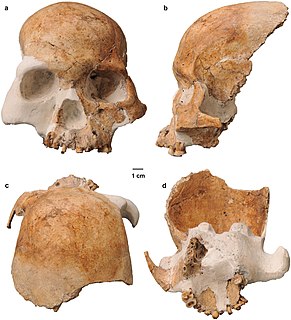 W
WThis is a list of Paleolithic sites in China. They are sorted in chronological order from the earliest founding to the latest:
 W
WBaishiya Karst Cave is a Tibetan Buddhist sanctuary and a high-altitude paleoanthropological site located on the northeastern edge of the Tibetan Plateau in Xiahe County, Gansu, China. This karst cave is the site of the discovery of the earliest hominin fossil found on the Tibetan Plateau, the Xiahe mandible. The mandible, by way of palaeoproteomic analysis, is the first confirmed discovery of a Denisovan fossil outside of Denisova Cave. This fossil discovery shows that archaic hominins were present in a high-altitude, low-oxygen environment by around 160,000 years ago.
 W
WThe Bose Basin is in the western part of Guangxi province in southern China, around the city of Baise (Bose), and is the site of the oldest known cutting tools of the Acheulean archaeological industry in China. It is about 800 square kilometres (300 sq mi) in area.
 W
WFuyan Cave is a complex of limestone caves in Tangbei village, Lefutang town, Daoxian, Hunan province, south central China famous for the discovery of the oldest evidence for unambiguously fully modern humans outside Africa. 47 human teeth, dating to between 80,000 and 120,000 years ago, were discovered at Fuyan Cave. The teeth are also unusual for showing signs of cavities, a feature typically not found in teeth older than 50,000 years.
 W
WJinniushan is a Middle Pleistocene paleoanthropological site, dating to around 260,000 BP, most famous for its archaic hominin fossils. The site is located near Yingkou, Liaoning, China. Several new species of extinct birds were also discovered at the site.
 W
WNwya Devu is a high-altitude archaeological site on the Tibetan Plateau located in the eastern Changtang region of Tibet. At around 4,600 m (15,092 ft) above sea level, Nwya Devu is the highest known archaeological site from the Paleolithic and provides evidence for one of the earliest known presences of humans at a high-altitude site, at around 40,000-30,000 BP.
 W
WThe Red Deer Cave people are a prehistoric archaic human population. Fossils dated to the Bølling-Allerød warming, between about 14,500 to c. 11,500 years ago, were found in Red Deer Cave and Longlin Cave, Yunnan Province, in Southwest China.
 W
WShangchen is a Lower Palaeolithic archaeological site in Lantian County, Shaanxi, China, some 25 km south of Weinan. It was discovered in 1964, and excavated during 2004 and 2017.
 W
WGangga is a town in Tingri County, in the south of the Tibet Autonomous Region. It has a population of around 523, and is often used as a base by mountain climbers preparing to ascend Mount Everest or Cho Oyu. It is known for its views of Mount Everest, Mount Lhotse, Mount Makalu, and Cho Oyu, which comprise four of the six highest mountains in the world.
 W
WXiaochangliang is the site of some of the earliest paleolithic remains in East Asia, located in the Nihewan Basin in Yangyuan County, Hebei, China, most famous for the stone tools discovered there.
 W
WXihoudu is an archeological site located in the Shanxi Province of China. The site dates to the Paleolithic Age. In total 32 stone implements were found at the site.
 W
WXujiayao, located in the Nihewan Basin in China, is an early Late Pleistocene paleoanthropological site famous for its archaic hominin fossils.
 W
WZhoukoudian Peking Man Site (周口店北京人遗址), also romanized as Choukoutien, is a cave system in suburban Fangshan District, Beijing. It has yielded many archaeological discoveries, including one of the first specimens of Homo erectus, dubbed Peking Man, and a fine assemblage of bones of the gigantic hyena Pachycrocuta brevirostris.